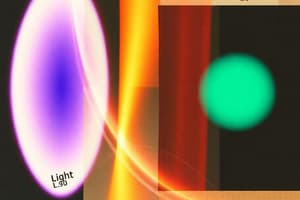Podcast
Questions and Answers
What phenomenon explains why stars appear to twinkle when observed from Earth?
What phenomenon explains why stars appear to twinkle when observed from Earth?
- Dispersion of light
- Reflection of light
- Scattering of light (correct)
- Refraction of light
Which of the following sources of energy is considered renewable?
Which of the following sources of energy is considered renewable?
- Fossil Fuels
- Natural Gas
- Nuclear Energy
- Solar Energy (correct)
What is the relationship between power (P), voltage (V), and current (I) in an electrical circuit?
What is the relationship between power (P), voltage (V), and current (I) in an electrical circuit?
- P = V + I
- P = V / I
- P = V * I (correct)
- P = I - V
What principle explains why objects float or sink in a fluid?
What principle explains why objects float or sink in a fluid?
Which law explains the relationship between the volume and temperature of a gas at constant pressure?
Which law explains the relationship between the volume and temperature of a gas at constant pressure?
What type of motion describes an object moving in a circle at a constant speed?
What type of motion describes an object moving in a circle at a constant speed?
Which statement correctly describes the relationship between mass and weight?
Which statement correctly describes the relationship between mass and weight?
What kind of energy is associated with an object's position and is defined as the potential to do work?
What kind of energy is associated with an object's position and is defined as the potential to do work?
What is the primary effect of electric current flowing through a conductor?
What is the primary effect of electric current flowing through a conductor?
What is the term for the resistance offered by a fluid to an object's motion through it, which affects buoyancy?
What is the term for the resistance offered by a fluid to an object's motion through it, which affects buoyancy?
Flashcards
Ohm's Law
Ohm's Law
The current through a conductor between two points is directly proportional to the voltage across the two points.
Series Resistors
Series Resistors
Resistors connected end-to-end in a circuit.
Parallel Resistors
Parallel Resistors
Resistors connected across a common voltage in a circuit.
Electromagnetic Induction
Electromagnetic Induction
Signup and view all the flashcards
Concave Mirror
Concave Mirror
Signup and view all the flashcards
Refraction
Refraction
Signup and view all the flashcards
Renewable Energy
Renewable Energy
Signup and view all the flashcards
Newton's Laws of Motion
Newton's Laws of Motion
Signup and view all the flashcards
Kinetic Energy
Kinetic Energy
Signup and view all the flashcards
Archimedes' Principle
Archimedes' Principle
Signup and view all the flashcards
Study Notes
Effect of Current
- Potential difference, Ohm's law
- Series and parallel combinations of resistors
- Power dissipation due to current
- Relation between P, V, I, and R
- Magnetic field and magnetic lines
- Magnetic field due to current-carrying conductor
- Fleming left-hand rule
- Electromagnetic induction
- Induced potential difference
- Induced current
- Direct current (DC)
- Alternating current (AC)
- Advantages of electronic motor and electronic generator
- Frequency of AC
Light
- Convergence and divergence of light
- Images formed by concave mirrors
- Centre of curvature, principle axis, optic centre, focus, focal length
- Refraction and laws of refraction
- Images formed by convex lenses
- Functioning of vision and remedies
- Applications of spherical mirrors and lenses
- Appreciation of refraction index
- Twinkling of stars
- Dispersion of light
- Scattering of light
Sources of Energy
- Different forms of energy
- Leading to different sources for human use
- Fossil fuels (examples needed)
- Solar energy
- Biogas
- Wind
- Water and Tidal Energy
- Nuclear Energy
- Renewable versus non-renewable sources
Motion: Force and Newton's Laws
- Displacement, velocity
- Uniform and non-uniform motion
- Time graphs for uniform and uniformly accelerated motion
- Equations of motion
- Elementary idea of uniform circular motion
- Newton's laws of motion
- Inertia of a body
- Inertia and mass
- Momentum
- Force and acceleration
- Elementary idea of conservation of momentum
- Action and Reaction forces
Gravitation: Work, Energy, and Power
- Gravitation
- Universal Law of Gravitation
- Force of gravitation and gravity
- Acceleration due to gravity
- Mass and weight
- Free fall
- Work done by a force
- Energy
- Power
- Kinetic and potential energy
- Law of conservation of energy
Floatation
- Thrust and pressure
- Archimedes Principle
- Buoyancy
- Relative density
Sound
- Nature of sound and its propagation
- Speed of sound
- Range of hearing in humans
- Ultra sound
- Reflection of sound, echo, SONAR
- Structure of the human ear (auditory aspect only)
Matter-Nature and Behavior: States of Matter
- Gases, liquids, solids, plasma, and Bose-Einstein condensate
- Types of intermolecular forces
- Classification of matter
- Mixtures and pure substances
- Henry's Law
- Concentration of solutions
- Colloids
- Phases of colloids, Tyndall effect, Brownian movement
- Suspension
- Measurement of properties of matter using SI units
- Physical and chemical changes
- Properties of matter
Structure of Atom
- Laws of chemical combination
- Gay Lussac's law
- Avogadro's law
- Atomic and molecular masses
- Average atomic mass
- Mole concept and molar masses
- Percentage composition
Studying That Suits You
Use AI to generate personalized quizzes and flashcards to suit your learning preferences.
Description
Explore the fundamentals of electricity, light, and energy sources in this comprehensive quiz. Topics include Ohm's law, the behavior of light through lenses and mirrors, and various energy forms. Enhance your understanding of magnetic fields, electromagnetism, and energy conservation through engaging questions.




